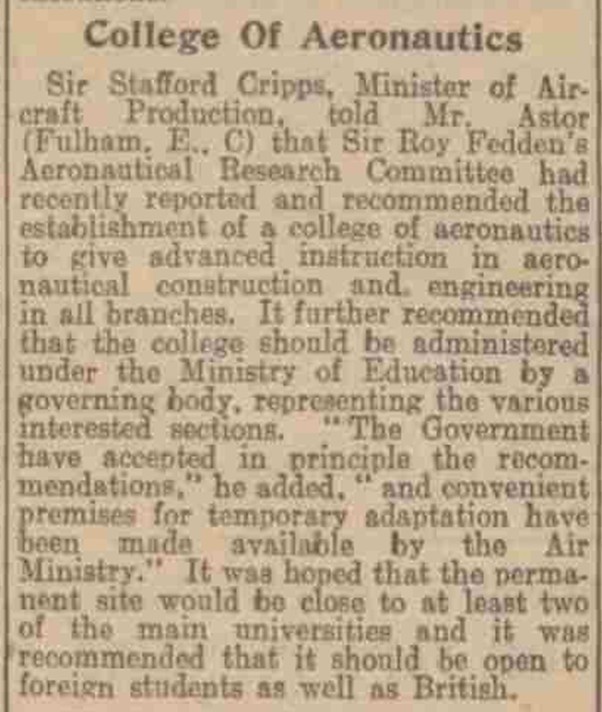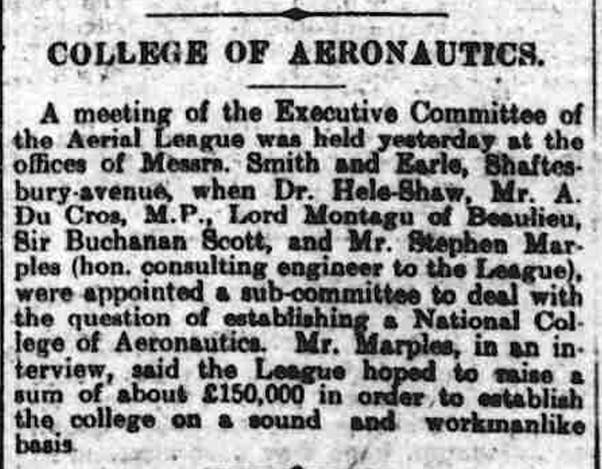In the mid-1930s Europe was in political turmoil. Fascists ruled in some countries; democracy struggled elsewhere during times of economic depression. War, it seemed, was coming, and in Britain one manifestation of a drive to re-arm was the creation of new airfields. Including RAF Cranfield, a few miles south-west of Bedford.
War did indeed come, and during the war, the British government sought to learn lessons from America. One of these was the quality of engineering education which supported aeronautics, and a decision was made to create a specialist college, at postgraduate level, to train aeronautical engineers. After the war, this decision was enacted. Money was tight, so RAF Cranfield was the preferred location, and the existing buildings were repurposed. Hangers for labs, barracks for common rooms and halls of residence. The College of Aeronautics was born.

As the clipping from the Liverpool Daily Post of 13 October 1944 shows, this was not a military school, but was funded directly by the government. Its remit was all matters to do with aeronautics, and its four departments – aerodynamics, aircraft design, aircraft propulsion, and flight – reflected this. And although its early academic progress was good, it struggled financially. The governors sought additional funds from the Treasury, and considered broadening the scope of the college’s work, to enable it to attract more students and grow income. By the early 1960s the college had gained the freehold to its land, and a new approach to governance gave the principal more autonomy within the college.
And as defence needs changed, the college began to broaden its scope from human-controlled flight, into other areas of engineering and mathematics. Following the recommendations of the Robbins report, the college was moved to sit under the auspices of the University Grants Committee. And by 1967 the college was seeking a royal charter to cement its position as an autonomous higher-education institution; and which now included a management school. The charter was granted in 1969: the Cranfield Institute of Technology was born.
There’s a very readable history of the College of Aeronautics on the Cranfield website, which has provided me with much of the material above. Well worth a read!
An important person in the early years of the College was Sir Roy Fedden. A distinguished designer of aero-engines, Fedden was also the person chosen by Stafford Cripps, then Minister of Air Production, to undertake the study trip to the USA to learn about production methods. It was he who was impressed with US engineering education, and he who made the case for a specialist college. Subsequently he chaired the governmental committee which turned the desire to create a college into a reality. He also served, for many years, as a governor, and opposed Cranfield’s diversification away from aeronautics.
(As an aside, I wonder how different things might have been had the Aerial League’s plans for a College of Aeronautics, as set out in the Daily News of Saturday 24 April 1909, been delivered. Where would the college on which this blog is written have been based?)

The Cranfield Institute of Technology was extant between 1969 and 1993, during which time it incorporated, in 1975, the National College of Agricultural Engineering at Silsoe and developed a partnership with the then Royal Military College of Science at Shrivenham. Shrivenham is now part of Cranfield University; Silsoe is no more.
In 1993 the Cranfield Institute of Technology became Cranfield University. This was soon after the 1992 Further and Higher Education Act had transformed polytechnics into universities, so I daresay some of the driver was the need to demonstrate status. Cranfield also, in 2003, admitted its final cohort of undergraduate students, and became postgraduate only, reverting to its original roots.
Cranfield was recently partner to Milton Keynes Council in a bid to establish a new university in Milton Keynes – MK:U. The hoped-for public money did not materialise, but the partnership continues, with a particular focus, it seems, on apprenticeships. Cranfield also tried an overseas campus, in Australia, but this didn’t work out either. I highlight these things not to shame Cranfield, but to illustrate how hard it is for universities to innovate successfully – for every venture that works, two or three won’t. And it isn’t obvious ahead of time what is a good call and what a bad. Such are the perils of a market-driven system, where universities are encouraged to act like businesses.
Anyway, that’s Cranfield University. It has an airport, which evolved from the original RAF station, and there’s a brief history here with some good photographs here. I think it might be the only university in the UK with its own airport. Marjon and UEL are very near airports, but that’s not at all the same thing.
And, for those of you that like puzzles, here’s a jigsaw of the postcard. For those of you that don’t, I wouldn’t click on the link.
And finally a quiz question: how many postgraduate-only universities or higher education institutions are there in the UK? Autonomous ones only, please – All Souls Oxford, for example, doesn’t count.
Hugh Jones’ daily #HigherEducationPostcard is now on Bluesky.













Having grown up in Cranfield, I very well remember the days of CIT. The village is the other side of the airfield so slightly separated from the (now) Uni, but I used to work in the little greengrocers/florists there as a teenager (sadly it is no longer there) and my mum worked in the NatWest Bank before moving to work in the pioneering Ecotechnology Research Centre (affectionately known as the Pizza Hut building so I’m led to believe). Nice to hear a bit more of the history.
Not many active UK universities with a live fire range either (thank you Royal Military College) at which a technican role in ordnance disposal is currently looking for a brave new postholder.